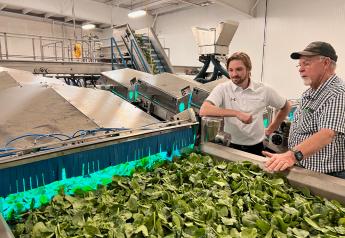What’s next in our lean toward Amazon?

The empty nest Karst household has fallen to a way of shopping for some “groceries” online.
To put a finer point on it, we order Starbucks breakfast blend medium roast ground coffee every couple of weeks. It arrives on our doorstep a couple days after we click the Amazon Prime dash button.
Hitting that virtual button to reorder coffee saves us a special trip to the big box store a couple of miles away or an even more-time consuming jaunt to our preferred supermarket.
It may be sacrilege to admit, but I wouldn’t object if we could order milk, bread and a bag of apples this way.
E-commerce sales of food are on the rise, and the produce industry has to figure out how to make fresh a big part of the online experience.
The Census Bureau recently reported 2016 e-commerce sales from food and beverage stores totaled $1.42 billion, up 25% from 2015 and 58% higher than 2014. By way of context, Census Bureau numbers said total e-commerce sales in 2016 were $332 billion, up 16% from $287 billion in 2015. At $22.3 billion, e-commerce sales from electronics and appliance stores in 2016 were much higher than food stores, bureau statistics showed.
That is to be expected, since the ritual of buying a television online is already a part of Americana, at least compared with buying a loaf of bread or a bag of apples.
However, the growth rate wasn’t as brisk as food and beverage stores. Online sales of electronics and appliances grew 13% in 2016 over 2015.
Census Bureau statistics show that total sales from food and beverage stores (mostly supermarkets) notched $700.8 billion in 2016, up 2% from $685.3 billion in 2015.
In 2016, sales of electronics and appliance stores totaled $98.8 billion, off 4% from $103.7 billion in 2015.
But what are the e-commerce sales from non-store retailers, such as Amazon?
The Census Bureau reports that e-commerce sales of non-store retailers tallied a whopping $226 billion in 2016, up 20% from $189 billion in 2015 and up 43% over 2015 sales of $158 billion in 2014.According to coverage of a One Click Retail study by CNBC, Amazon in 2017 accounted for 44% of all e-commerce sales and about 4% of total U.S. retail sales. Amazon’s e-commerce sales for 2017 were expected near $197 billion, up 32% compared with 2016.
According to the study, Amazon’s grocery sales in 2017 totaled $1.5 billion, up 33% compared with 2016. Grocery is among the top growth categories for Amazon, along with pantry items (up 38% from 2016), luxury/beauty items (up 48% over 2016) and furniture (up 33%).
When it comes to e-commerce, there is Amazon, and there is everyone else.
If everyman’s definition of Americana ever translates to ordering a loaf of bread and a bag of apples online, Amazon will likely be right there to deliver it.
I won’t be complaining when it happens.
Tom Karst is The Packer’s national editor. E-mail him at tkarst@farmjournal.com.







